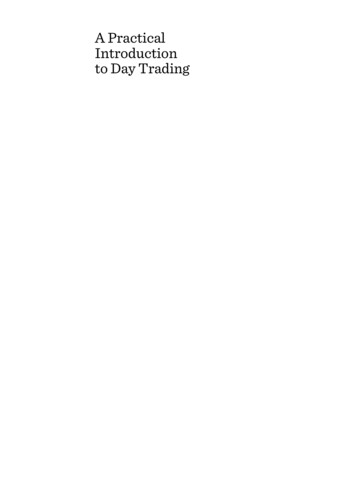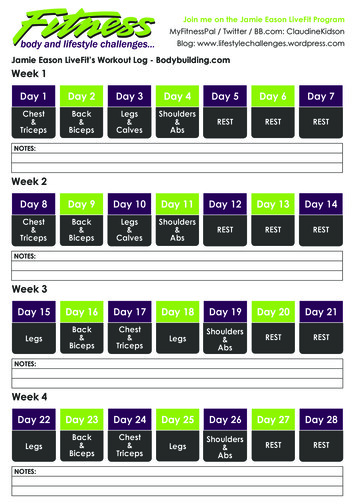
Transcription
A PracticalIntroductionto Day Trading
A PracticalIntroductionto Day TradingByDon Charles
A Practical Introduction to Day TradingBy Don CharlesThis book first published 2018Cambridge Scholars PublishingLady Stephenson Library, Newcastle upon Tyne, NE6 2PA, UKBritish Library Cataloguing in Publication DataA catalogue record for this book is available from the British LibraryCopyright 2018 by Don CharlesAll rights for this book reserved. No part of this book may be reproduced,stored in a retrieval system, or transmitted, in any form or by any means,electronic, mechanical, photocopying, recording or otherwise, withoutthe prior permission of the copyright owner.ISBN (10): 1-5275-1599-0ISBN (13): 978-1-5275-1599-4
TABLE OF CONTENTSPreface . ixChapter One . 1General Introduction1.0 Trading . 11.1 Trading Styles . 21.2 Portfolio Allocation . 41.3 Profit Loss Ratios. 51.4 Book Objectives . 51.5 Outline of Book . 61.6 Summary Insight . 6Chapter Two . 7Day Trading2.0 Introduction . 72.1 Where Assets are Traded . 72.1.1 The Forex Market . 82.2 Day Trading . 102.3 Opening an Account . 132.4 Important Questions to Consider Before Trading . 182.4.1 Types of Orders . 202.4.2 Level 1 and Level 2 data . 222.5 How to Find Stocks to Trade . 242.5.1 Stock Scanners . 252.6 Creating a Watch-List . 272.6.1 Top-Down Analysis . 272.6.2 Fundamental Analysis . 282.6.3 Technical Analysis . 322.7 Summary Insight . 32
viTable of ContentsChapter Three . 33Technical Tools and Technical Analysis3.0 Introduction . 333.1 Technical Analysis . 333.2 Candlesticks . 343.2.1 Heikin-Ashi Candlestick . 383.3 Types of Markets . 383.4 Chart Patterns . 393.4.1 The Elliott Wave Theory . 493.5 Oscillators . 543.5.1 Momentum Oscillator. 553.5.2 On-Balance-Volume. 553.5.3 Relative Strength Index . 553.5.4 Relatove Volume . 563.5.5 Money Flow Index . 563.5.6 Stochastic Oscillator . 573.5.7 Fibonacci Retracement Levels . 583.5.8 Force Index . 603.6 Moving Averages . 623.6.1 Simple Moving Average . 623.6.2 Exponentially Weighted Moving Average . 653.6.3 Volume Weighted Moving Average . 663.6.4 Moving Average Convergence Divergence . 663.7 Bollinger Bands: Another Technical Indicator . 673.8 Linear Regression Models . 683.9 Summary Insight . 76Chapter Four . 77Trading Strategies4.0 Introduction . 774.1 Trading Strategies . 774.1.1 Crossovers . 784.1.2 Moving Average Envelopes and Bollinger Bands. 824.1.3 Momentum . 824.1.4 Volatility Breakouts . 844.1.5 Reversals . 844.1.6 Events Trading . 854.1.7 Heikin-Ashi . 884.1.8 Elliott Wave Based Trading . 884.2 Evaluating the Trading Strategy . 904.3 Summary Insight . 91
A Practical Introduction to Day TradingviiChapter Five . 93Risk Management5.0 Introduction . 945.1 Types of Risk . 945.1.1 Market Risk . 945.1.2 Liquidity Risk . 955.1.3 Concentration Risk . 965.1.4 Credit Risk . 985.1.5 Inflation Risk . 995.2 When to open a Position . 995.3 When to close a Position . 1005.4 Position Sizing and Balancing Risk . 1045.5 Common Mistakes . 1075.6 Summary Insight . 107Chapter Six . 109The Average Trading Day and General Conclusion6.0 Introduction . 1096.1 Mechanical Trading Systems . 1096.2 The Average Trading Day for the Informed Stock Trader . 1126.3 A Practical Mechanical Trading System for Trading Currencies . 1146.4 Trading Plan . 1156.5 Conclusion . 116References . 119
PREFACEMany individuals enter financial markets with the objective to earn aprofit from capitalizing on price fluctuations. However, many of these newtraders lose their money in trading. The reason for this is often becausethese new traders lack any fundamental understanding of financialmarkets, they cannot interpret any data, and they have no strategy fortrading.Trading on financial exchanges is really about deploying strategies tosystematically generate gains, and managing risks to minimize losses.Indeed, successful traders do have objective strategies which they haveproved to be effective in granting them more financial gains than financialloss.The purpose of this book is to help a potentially uninformed retailtrader or inquisitive reader understand more about financial markets, andassist them in the acquisition of the technical skills required to profit fromtrading. This book is a beginner’s guide to trading. It focuses mainly ontrades of stocks and currencies on Exchanges. While some of the analysiscan be useful for other assets such as futures, commodities, and options,the analysis will not always be relevant for such markets.The first chapter of this book introduces the reader to some keyconcepts in the trading industry. The distinction is made between tradingand investing. The second chapter introduces the reader to day trading. Itinforms the reader of the basic information that they need to know beforethey attempt to trade in any market. The third chapter introduces the readerto Technical Analysis. It informs how to interpret charts, and how torecognize patterns in asset prices. The fourth chapter considers some basictrading strategies which may be used by retail traders. The fifth chapterconsiders how a retail trader may manage risk. Finally, the sixth chapterconcludes with a practical example of a trading strategy.
CHAPTER ONEGENERAL INTRODUCTION1.0 TradingTrading is the practice of buying and selling assets over a short-termperiod. Assets here refer to any financial security, commodity, or currencythat an economic agent purchased. Market participants that practicetrading are referred to as traders.A distinction can be made between a retail trader and an institutionaltrader. A retail trader refers to a trader that trades independently forthemselves. An institutional trader refers to a trader that is employed by afinancial institution (for example a commercial bank, investment bank, orhedge fund) and perform trading activities as part of their job description.Trading is distinct from investing. Investing refers to the practice ofpurchasing assets with the objective of gradually growing wealth from theasset over a period of time. The market participant may purchase a rangeof assets1, and hold the portfolio2 of assets over a period of time. While theprice of the assets in the portfolio may fluctuate over time, the goal of theeconomic agent is to ride out the short-term price fluctuations andgradually earn a positive return3 over a period of time. Market participantsthat engage in the practice of investing are typically referred to asinvestors.While investors seek to earn a return, perhaps with a range of 5% to15%, over a year, traders seek to make such returns over a much shortertime period, ranging from a day to a few weeks. Traders try to takeadvantage of short-term price fluctuations in assets. When they execute1Some of these assets may include stocks, bonds, mutual funds, exchange tradedfunds and other investment instruments.2A portfolio is a group of assets.3The return is the profit from an asset. It is gain (loss) from price increases(decreases) plus the gains from dividends if any are paid.
Chapter One2trades, they try to buy assets and sell them just a few dollars or centshigher. However, the make large profits by trading large volumes of assetswith each trade.Traders can be categorized basis upon their style of trading. The nextsection will explore different trading styles.1.1 Trading StylesIn summary, trading styles may be categorized into the following: Position trading;Swing trading;Scalping; andDay trading.Position trading is where the position is held by the economic agent forseveral weeks to several months. Position traders first try to identifytrends4 in the price of assets. If they expect a bullish trend5, then theywould go long6 on the asset. If they detect a bearish trend, they may shortsell7 the asset.Position traders may not necessarily try to forecast the future prices ofthe asset, rather they try to ride the ‘wave’ of the trend which has beenfirmly established, and benefit from the overall movement of a stock in amarket. Position traders typically exit a position when the trend breaks.4Here a trend refers to a sustained movement in the price of an asset.A bullish trend is an upward trend or upward price movement. The opposite of abullish trend is a bearish trend. A bearish trend is a downward price movement.6Going long refers to buying an asset.7Short selling refers to where an economic agent has sold an asset that they do notown. In essence, they have borrowed the asset from their broker and sold it.However, eventually the economic agent would have to repurchase the asset,perhaps when it falls to a lower price, and return the asset to their broker. When theeconomic agent returns the asset to the broker, it is referred as a ‘cover’. It isimportant to note, the US Securities and Exchange Commission adopted a ShortSale Restriction (SSR) rule since February 2010 (US SEC 2016). Once this rule isactivated, economic agents can only short sell the asset once the price is going up.This rule was devised in order to prevent crashes from occurring as a consequenceof too many economic agents short selling an asset while its price is declining.5
General Introduction3Swing trading is where a market participant holds a position for a fewdays, to a few weeks. Once the trader holds more than few weeks, it iscalled position trading. Swing trading is slower paced than day tradingsince the time frame for holding trades is longer. It is very important that aswing trader have a trading strategy, as stocks will be moving up anddown, but they will not be always available to constantly monitor themarket like a day trader.Scalping refers to where traders’ long (or short) assets, hold them for afew seconds or minutes then close the position. Scalpers try to exploitsmall moves in price by trading large volumes of the asset over a veryshort period of time. Scalpers try to take advantage of the volatility8 in themarket.Day trading refers to the practice of buying and selling assets in thesame day. Positions are not held overnight. All positions are closed withinthe same day. Day traders try to make profits by exploiting the volatility inan asset price in a day. Like scalpers, day traders profit by moving a largevolume of stocks. Day traders’ trading interval is the active hours of atrading day, whereas scalpers’ trading intervals range from a few secondsto a few minutes. When a trader opens and closes their position on an assetfrom an account, it is referred as a round-trip. Under the Pattern Day TradeRule, the Financial Industry Regulatory Authority (FINRA) only allowsthree (3) round-trips within a five (5) rolling day9 period. This rule onlyapplies to margin accounts10.118Volatility here refers to the tendency of the price of an asset to fluctuate.The five rolling days here refer to five consecutive trading days.10Margin accounts are the accounts held by the broker that allows the marketparticipant to trade on credit. For instance, if the trader has deposited 45,000 inthe account, if they are trading on margin, the broker may allow the trader to taketrades up to 90,000.11According to the FINRA, any account that places four day trades or more, withinin a five trading day period is permanently deemed to be a ‘pattern day trading’(PDT) account. The FINRA mandates that pattern day trading accounts maintain aminimum daily equity balance of US 25,000. If the account balance falls belowUS 25,000, traders can only perform closing transactions only until the accountbalance is increased to US 25,000. The FINRA deems Non-Day Trading Accountas any account that has never placed 4 trades within a 5-day period. Non-DayTrading Accounts are required to have an equity balance of at least US 5,000(Trade Station 2016).9
4Chapter OneTraders select their trading style based upon: the size of their tradingaccount; their level of experience; the amount of time they are willing todedicate to trading; and their risk tolerance12.1.2 Portfolio AllocationPortfolio allocation is the process by which the market participantdecides which assets should compose the portfolio. Two factors thatinfluence portfolio allocation are the time horizon and risk tolerance. Timehorizon refers to the age of the investor/ trader relative to their retirement.Generally, the longer the time horizon of an investor, the more risk theirportfolio can bear. This is due to longer time periods provide more timefor the investor to recover from losses. For example, assume an investormade a 25% loss in a portfolio this year. If that investor has a long timehorizon, then they have several years to recover from such loss.The risk tolerance refers to how much risk that an investor/ trader iswilling to take. Risk here is defined as the likelihood that an investmentmay earn a return lower than the expected return. However, the greater thereturns from an investment deviates from its expected returns, the riskierthe investment. In fact, the Risk-Return Tradeoff asserts that the returnsfrom an investment can be increased by taking larger risks. Investors/traders trying to make profits cannot eliminate all risks. Instead, theyshould try to find a balance between the desired return from theirinvestment and the associated risks. The risk tolerance of each investor isinfluenced by their personality as some investors are willing to take morerisks, with the goal of earning a profit, than others.Risk adverse investors with short horizon would prefer portfolioswhich have a high weight of income stocks13. On the other hand, investorswith a long horizon may prefer a portfolio with a higher weight of growth12Risk tolerance refers to how much loss a trader/ investor is willing to risk whiletrading/ investing.13Income stocks are equities that pay regular dividends. The dividend of incomestocks often increases over time (Reilly and Brown 2011).
General Introduction5stocks14. Moderate investors with moderate risk tolerance and time horizonmay prefer a portfolio with a higher weight of value stocks15.1.3 Profit Loss RatiosMany retail traders may trade ad-hoc, or they may go to forums andinquire about other market participants’ trades in order to mirror them.Such traders may fear that they may lose money, subsequently influencingtheir consistent search for the correct tool which can help them makeaccurate trades 100% of the time. Retail traders may be searching for the“Holy Grail”, the trading secret that would lead to instant profitability.Such search may be unjustified since it is possible for a trader to correctabout the market direction only 50% of the time yet still be profitable.Traders should be mindful of profit to loss ratios. If a retail trader cansuccessfully trade with a profit to loss ratio of at least 2:1 then they can beprofitable even if they are only accurate about the direction of the market50% of the time.Most traders who are unable to achieve financial success on financialmarkets do so because they are trading with a profit to loss ratio where theaverage size of their financial gain is less than the average size of theirfinancial loss. They could have a profit to loss ratio of 1:2 or even worse.Such statistics may be a result of the retail trader holding losses too long,or closing profitable positions too early. Throughout the course of thisbook, consideration is given to various tools and analytical techniqueswhich could result in the retail trader earning more financial gains thanlosses.1.4 Book ObjectivesTrading has the potential to general large profits in a very short periodof time. However, if an economic agent attempts to trade without firstunderstanding certain fundamentals about trading, they may lose largeamounts of money while trading. Moreover, they may incur losses withoutunderstanding why.14Growth stocks are equities of companies whose earnings are growing above theaverage market rate. Growth stocks rarely pay dividends since the companiesreinvest their earnings (Reilly and Brown 2011; Levin and Wyzalek 2014).15Value stocks are equities that are trading at a price that is low relative to itsfundamentals (Levin and Wyzalek 2014).
6Chapter OneThe objective of this book is to teach a potential reader, which islacking prior knowledge of finance, the relevant information aboutfinancial exchanges, and how to profit from day trading. This book seeksto provide a roadmap for the trader who desires to learn to trade from asystematic approach rather than based on ad-hoc decisions and emotions.A study of the guidelines presented herein will help identify andeliminate the causes of failure, such as a poor strategy, incorrect datainterpretation, poor risk management, and improper strategy evaluation.1.5 Outline of BookWhile several types of financial instruments are available on stockmarkets, this book focuses mainly on trading stocks and currencies.Chapter Two of this book will review basic concepts in trading. Itaddresses issues such as how to open an account, and how to identifystocks to trade.Chapter Three explores the technical tools used for trading. It reviewsmarket conditions, candlesticks, and chart patterns.Chapter Four considers a number of strategies which can be used by atrader to earn a profit. This will be supplemented by the strategies whichcan be used to manage risk in Chapter Five.Chapter Six probes into the average trading day of the marketparticipant, and presents a general conclusion.1.6 Summary InsightThis chapter reviewed the basic concepts of trading. First, this chaptermakes the distinction between trading and investing. Moreover, it makesthe distinction between day trading, scalping, swing trading, and investing.This chapter then outlines the general risk preferences of differenteconomic agents, and their predilection for portfolio allocation.Chapter Two, the next chapter, investigates the basic fundamentals ofday trading.
CHAPTER TWODAY TRADING2.0 IntroductionMany different economic agents enter financial markets, and may tradefinancial assets with the objective of making a profit. An uninformed butinterested economic agent may be unaware of how to begin the process toengage in day trading. This chapter outlines the process in which sucheconomic agent may open an account to engage in day trading. It starts byoutlining where assets are traded. Then, it explains the factors that theeconomic agent should consider before opening an account. This isfollowed by a review of how the economic agent may identify potentialstocks to trade; and an overview of the different analysis techniques thatthe economic agent may consider.2.1 Where Assets are TradedStocks and other financial securities are traded on exchanges. Anexchange is an organized market where securities, commodities,currencies, and derivatives are traded. Exchanges with a physical locationare referred to as centralized markets or centralized exchanges. Exchangesthat do not have a physical location are referred to as over-the-counter(OTC) markets.The top centralized exchanges in the world on the basis of marketcapitalization are the New York Stock Exchange (NYSE), the NASDAQ,the Tokyo Stock Exchange, the London Stock Exchange, and the ShanghaiStock Exchange. Within the Caribbean region, there are smallercentralized exchanges such as the Eastern Caribbean Securities Exchange(ECSE), the Barbados Stock Exchange, the Jamaica Stock Exchange, andthe Trinidad and Tobago Stock Exchange (TTSE). The smaller exchangestend to be less efficient than the exchanges in developed countries.
8Chapter Two2.1.1 The Forex MarketThe trade of foreign exchange, or forex, is considered as trade in anOTC market. This perception arises is due to the entire market being runelectronically, within a network of banks, continuously over a 24-hourperiod.The forex market is attractive for trading for a number of reasons. Theyinclude: i) the large size of the market; ii) the high market liquidity; iii)low transaction costs; iv) the 24-hour market; and v) low barriers to entry.The forex market is the largest financial market in the entire world. Infact, the market capitalization of the forex market is approximately US 6trillion a day (Nag and McGeever 2016), while the market capitalization ofthe NYSE, the largest exchange, is only US 45 billion a day (NYSE2017). The forex market is so large that it is difficult for any one marketparticipant to manipulate the market. In contrast, the stocks market is oftenmanipulated by large participants.The forex market is highly liquid. This is advantageous to traders as itmeans that they can immediately buy or sell forex at the market pricewhenever they desire. There will always be someone at the market willingto take the other side of the trade. Thus, a trader will never be stuck in aposition for a currency pair.A currency pair is the exchange rate or quotation for two currencies.For example, the Euro / United States dollar (EUR/USD), the UnitedStates dollar / Japan yen (USD/JPY), and the United Kingdom pound /United States dollar (GBP/USD) are currency pairs. It shows how muchunits of one country’s currency is traded for another country’s currency.The major, and most actively traded currency pairs are: EUR/USD,USD/CAD, AUD/USD, USD/JPY, GBP/USD, and USD/CHF. Severalcurrency pairs for developing countries are considered minor currencypairs, or exotics.The high liquidity and competition on the forex market results in lowspreads between bid and ask16. Such low spreads result in low transactioncosts per trade. In fact, for a trading factor of 0.01, some brokers may16The bid price is the price that the market participant offers to purchase the asset.The ask is the price that the holder of an asset requests for the sale of the asset. Theretail trader can sell an asset at the bid price, but purchases assets at the ask price.
Day Trading9charge a commission of only US 0.09 (9 cents). In contrast to the tradingof stocks, some brokers may charge US 5 per trade.The forex market is open 24 hours a day as a result of the overlappingof the majour markets. The forex market has four major trading sessions:the Sydney session; the Tokyo session; the London session; and the NewYork session. Table 2.1 below outlines the time for the majour tradingsessions.Table 2.1: Open and Close times for the Major Trading SessionsTime ZoneSydney OpenSydney CloseApril – OctoberEDT6:00 PM3:00 AMGMT10:00 PM7:00 AMTokyo OpenTokyo Close7:00 PM4:00 AM11:00 PM8:00 AMLondon OpenLondon Close3:00 AM12:00 PM7:00 AM4:00 PMNew York OpenNew York Close8:00 AM5:00 PM12:00 PM9:00 PMSydney OpenSydney CloseTokyo OpenTokyo CloseLondon OpenLondon CloseNew York OpenNew York CloseOctober – April4:00 PM1:00 AM6:00 PM3:00 AM3:00 AM12:00 PM8:00 AM5:00 PM9:00 PM6:00 AM11:00 PM8:00 AM8:00 AM5:00 PM1:00 PM10:00 PMThere are low barriers to entry to trade on the forex market. In fact, aretail trader17 can open an account to trade forex with as low as US 100.However, for stocks, the minimum account size allowed by brokers isUS 500.17A retail trader is a market participant that engages in the practice of tradingfinancial assets. Throughout the course of this book, the terms “retail trader”, and“market participant” will be used interchangeably.
10Chapter Two2.2 Day TradingThe objective of the day trader is to make money from small pricemovements in an asset. For simplicity, consider only stocks.18 Therefore,the day trader is trying to profit from small movements in the price ofstocks. This can be done by trading large volumes of the stock or takinglarger positions. These positions may be larger than what some economicagents may feel comfortable investing. However, the risk is managed sincethe position is held for a short period of time, a few minutes to a fewhours, and the trader monitors the prices while holding their position.To put day trading in context, consider the following example. Aneconomic agent can invest 20,000 in a mutual fund19 and earn perhaps a5% return per annum. This works out to be just 1,000. However, a daytrader could invest the same 20,000 by purchasing stocks in 1 day. If bythe end of the day, when the closed the position they made a profit of 5%,then they would make 1,000 that day. Thus, if the economic agentcontinues trading the same volume, it is possible to make a profit way inexcess of 5% in that year.A trader can find a stock whose price can move by at leas
the same day. Day traders try to make profits by exploiting the volatility in an asset price in a day. Like scalpers, day traders profit by moving a large volume of stocks. Day traders' trading interval is the active hours of a trading day, whereas scalpers' trading intervals range from a few seconds .

![Welcome [dashdiet.me]](/img/17/30-day-weight-loss-journal.jpg)









